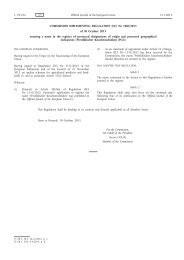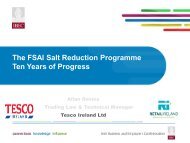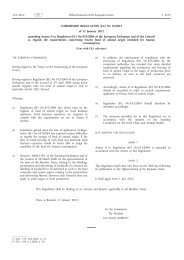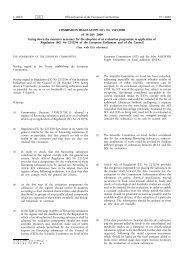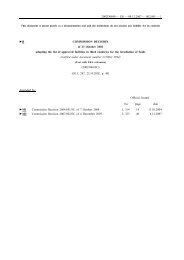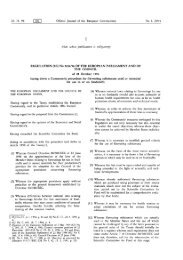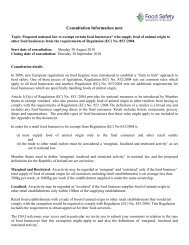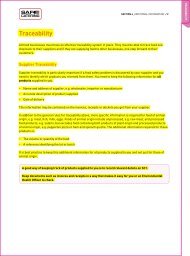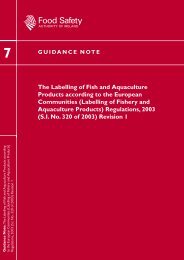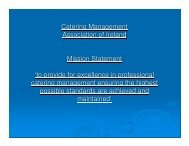Managing food contaminants - European Commission - Europa
Managing food contaminants - European Commission - Europa
Managing food contaminants - European Commission - Europa
You also want an ePaper? Increase the reach of your titles
YUMPU automatically turns print PDFs into web optimized ePapers that Google loves.
COnTROL And RESpOnSE<br />
The EU’s control and response procedures are based<br />
on a process of random checks undertaken by<br />
Member States. If a risk is identified, appropriate<br />
measures are rapidly taken.<br />
Member States perform random sampling and analysis<br />
of <strong>food</strong>stuffs, regularly report findings and take action if<br />
samples are not compliant with the legislation. The EU<br />
makes these findings available to all Member States.<br />
If, during their checks, national authorities identify a risk,<br />
they may temporarily suspend or restrict production or<br />
distribution of products. However, they must immediately<br />
inform the other Member States and the <strong>European</strong><br />
<strong>Commission</strong> and give reasons for their decision.<br />
RASFF (Rapid Alert System for Food and Feed) transmits<br />
information between national competent authorities, the<br />
<strong>European</strong> <strong>Commission</strong> and EFSA, enabling rapid action.<br />
Member States, the <strong>European</strong> <strong>Commission</strong>, EFSA, Norway,<br />
Iceland and Liechtenstein are members of the network.<br />
> http://ec.europa.eu/<strong>food</strong>/<strong>food</strong>/rapidalert/index_en.htm<br />
pROMOTInG BEST pRACTICE<br />
The EU promotes best practice among all those<br />
involved in the production, storage and delivery<br />
of <strong>food</strong> to ensure that contaminant levels are<br />
kept to a minimum. Some concrete examples are<br />
described below.<br />
PATUlIn<br />
Food <strong>contaminants</strong><br />
A good example of best practice is the EU’s approach to<br />
patulin in apple juice. Patulin is a toxic chemical produced<br />
by moulds and is commonly found in rotting apples and<br />
other mouldy fruit. While it is not a particularly potent<br />
toxin, it has been shown to be a carcinogen. As a result, EU<br />
rules establish maximum levels for patulin for apple juice<br />
and apple juice ingredients in other beverages.<br />
The <strong>European</strong> <strong>Commission</strong> deploys the Food and Veterinary<br />
Office to investigate the correct application of legal provisions<br />
and prevention measures in Member States and third countries.<br />
It then makes, and subsequently follows up, recommendations<br />
which must be enforced by national authorities.<br />
> http://ec.europa.eu/<strong>food</strong>/fvo/index_en.htm<br />
In addition, because the handling and storage of fruit<br />
affect the probability of patulin contamination of juice,<br />
the EU has put forward a Code of Practice for the<br />
apple processing industry. This code includes good<br />
manufacturing practices relating to, for example, careful<br />
pruning of trees, handling fruit to minimise damage and<br />
keeping fruit dry once harvested.<br />
> http://eur-lex.europa.eu/smartapi/cgi/sga_doc?smartapi!ce<br />
lexapi!prod!CELEXnumdoc&lg=EN&numdoc=32003H0598<br />
&model=guichett<br />
FUSArIUm ToxInS<br />
Toxin-producing fusarium fungi are commonly found on<br />
cereals grown in the temperate regions of Europe, America<br />
and Asia. Such toxins have been shown to cause toxic effects<br />
in both experimental animals and livestock, and have also<br />
been suspected to cause high levels of toxicity in humans.<br />
Together with setting maximum levels, the EU promotes a<br />
range of good agricultural practices during the handling,<br />
storage, processing and distribution of cereals for human<br />
<strong>food</strong> and animal feed, in order to prevent or minimise<br />
contamination by fusarium toxins. These practices include<br />
crop rotation, timely harvesting and dry storage.<br />
> http://eur-lex.europa.eu/LexUriServ/LexUriServ.<br />
do?uri=CELEX:32006H0583:EN:NOT



